The seminar focuses on key works of visual culture, each of which is accompanied by a scholarly text. Together, we will analyze the visual works, referring to the texts we read. Scholars will join us to talk about their own research, giving participants an opportunity to ask questions and enrich their learning. Visits to museums, special collections, and with artists will provide hands-on opportunities to explore works of art relevant to the seminar. The following are some highlights of objects of visual culture and scholarly texts that we will examine (texts will be available to participants via a shared drive):
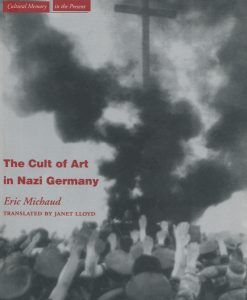 Leni Riefenstahl’s 1935 film Triumph of the Will, which captures dimensions of Nazi political culture and was in itself a central part of it, read in tandem with Eric Michaud’s The Cult of Art in Nazi Germany (2004), focusing especially representations of the “Hitler myth” and the idealization of the Volksgemeinschaft (people’s community).
Leni Riefenstahl’s 1935 film Triumph of the Will, which captures dimensions of Nazi political culture and was in itself a central part of it, read in tandem with Eric Michaud’s The Cult of Art in Nazi Germany (2004), focusing especially representations of the “Hitler myth” and the idealization of the Volksgemeinschaft (people’s community).
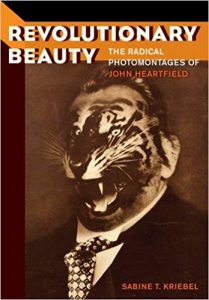 John Heartfield’s 1930s photomontages document the rise of Hitler and bombing of the Reichstag and were published in the left-wing weekly Arbeiter Illustrierte Zeitung (AIZ) (Worker’s Illustrated Newspaper) in the 1930s. Works such as Hitler Swallows Gold and Spouts Junk, for instance, demonstrates how capitalism and fascism played hand-in-hand. We will read Sabine T. Kriebel’s “Photomontage in the Year 1932,” a chapter in her book Revolutionary Beauty: The Radical Photomontages of John Heartfield (2014), which offers the first sustained study of Heartfield’s groundbreaking political photomontages.
John Heartfield’s 1930s photomontages document the rise of Hitler and bombing of the Reichstag and were published in the left-wing weekly Arbeiter Illustrierte Zeitung (AIZ) (Worker’s Illustrated Newspaper) in the 1930s. Works such as Hitler Swallows Gold and Spouts Junk, for instance, demonstrates how capitalism and fascism played hand-in-hand. We will read Sabine T. Kriebel’s “Photomontage in the Year 1932,” a chapter in her book Revolutionary Beauty: The Radical Photomontages of John Heartfield (2014), which offers the first sustained study of Heartfield’s groundbreaking political photomontages.
Nazi visual propaganda (which Heartfield used in his photomontages) in the form of Nazi posters, advertisements, and film. We will read selections from Claudia Koonz’s book The Nazi Conscience (2003), which both outlines the Nazis’ racial and ethnocentric thinking, and shows how Nazi public relations experts tried to “sell” their ideas to the German public often through visual means.
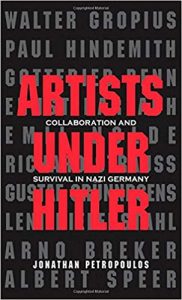 Jonathan Petropoulos will lead a discussion on Nazi ideology and visual culture, based on his essay “Accommodation Realized,” in Artists Under Hitler: Collaborations and Survival in Nazi Germany (2014). The essay focuses on Leni Riefenstahl and demonstrates how she was forced to make excruciating choices in her work — often with grave moral consequences.
Jonathan Petropoulos will lead a discussion on Nazi ideology and visual culture, based on his essay “Accommodation Realized,” in Artists Under Hitler: Collaborations and Survival in Nazi Germany (2014). The essay focuses on Leni Riefenstahl and demonstrates how she was forced to make excruciating choices in her work — often with grave moral consequences.
We will examine the July 1937 Degenerate Art Exhibition, which was the public denunciation of the great avant-garde modern masters of Europe and beyond, as well as the fate of those artists. We will also examine Nazi art exhibited in the Great German Art Exhibition of the same year. Visiting scholar Jonathan Petropoulos will lead a discussion of his chapter, “Culture and Barbarism: Architecture and Arts in Nazi Germany,” from The Oxford Illustrated History of the Third Reich (2018). In the afternoon, we will continue our discussion on the same theme. Petropoulos will join in our conversation.
Maia-Mari Sutnik’s Memory Unearthed: The Lodz Ghetto Photographs of Henryk Ross (2015), documents everyday life of Jews in confinement and which encourages us to focus on the lived experiences of Jews, including the celebration of family life and holidays. Our discussion of Reading Charlotte Salomon (2006) continues with this theme, as we study Salomon’s Life or Theatre? (1941–1943), a painting series of over seven hundred small works created when she was living in Berlin under Hitler and in hiding in France, until she was deported and murdered in Auschwitz.
A discussion of Kristallnacht (the Night of Broken Glass, when Jewish establishments and synagogues were burned throughout Germany), and the invasion of Poland, which started Germany’s aggressive grab for land to fulfill the need for “Lebensraum”—or Aryan “living space”–will be accompanied by a discussion of Art Spiegelman’s Maus (1986–1991). As many participants will have already taught Maus, this will present another opportunity for the whole group to share their own experiences and techniques in the classroom.
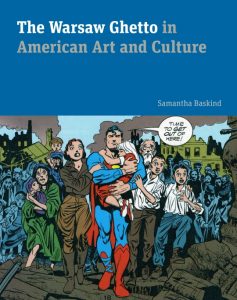 Visiting scholar Samantha Baskind will lead a discussion, based on her book, The Warsaw Ghetto Uprising in American Art and Culture (2018), of the history of Nathan Rapoport’s Warsaw Ghetto Uprising Monument (1948), which depicts the resistance of Warsaw’s Jews and became an icon of Holocaust remembrance in the post-war period. Baskind will discuss the Warsaw Ghetto Uprising in the context of American popular culture and Holocaust memory.
Visiting scholar Samantha Baskind will lead a discussion, based on her book, The Warsaw Ghetto Uprising in American Art and Culture (2018), of the history of Nathan Rapoport’s Warsaw Ghetto Uprising Monument (1948), which depicts the resistance of Warsaw’s Jews and became an icon of Holocaust remembrance in the post-war period. Baskind will discuss the Warsaw Ghetto Uprising in the context of American popular culture and Holocaust memory.
Natasha Goldman will lead a discussion of her essay on Holocaust memory in East Germany, “From Ravensbrück to Berlin: Will Lammert’s Memorial to the Deported Jews of Berlin.” We will end with Peter Eisenman’s 2005 Memorial to the Murdered Jews of Europe and Norman Foster’s 2005 re- building of the Reichstag cupola. While the former is a testament to the working through of German guilt, the other is a witness to the transparency of German democracy: visitors can actually walk up into the Reichstag cupola and look down into the Parliament.
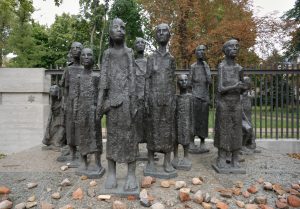
Will Lammert, Memorial to the Deported Jews, 1957/89, Grosse Hamburger Strasse, Berlin, Germany. Photo: Jochen Teufel.
Visits to sites for activities with works of art include: Bowdoin Special Collections, where we will examine an original artist’s book about the Holocaust, the Bowdoin College Museum of Art, where we will see original works of art by artists who would have been considered “degenerate” by the Nazis, and the Holocaust and Human Rights Center of Maine, where we will visit a photo/video installation by Maine artist Robert Katz.